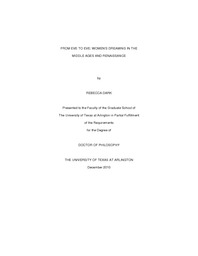| dc.description.abstract | This project examines reports of the dreams of women in fictionalized as well as historical, biographical, and hagiographical accounts from the English Middle Ages and Renaissance. Because an unstable body/spirit dualism forms the basis for both dream theory and anti-feminism during these periods, in texts where women's dreams are reported the instabilities of the two discourses are magnified, resulting in discursive discontinuities that reveal the presence of multiple cultural languages. My argument, based in part on the Bakhtinian concept of heteroglossia, is that these texts are characterized by the generally accepted misogynistic ideas of the period but also demonstrate the possibility of alternate expressions of feminine validation and agency. In fictionalized accounts of women's dreams from Old and Middle English texts, women's dreams are repeatedly connected with the concept of deception, portraying the woman dreamer in the position of deceived, deceiver, or both. Texts as diverse as Genesis B, Middle English poetic and dramatic portrayals of the dream of Pilate's wife, and the works of Chaucer consistently demonstrate this association and often draw on traditions of Eve as the deceived deceiver who bears the guilt for the Fall of mankind. In dramatic accounts from the early modern period, including among others A Midsummer Night's Dream, Antony and Cleopatra, Julius Caesar, and The White Devil, women's dreams are generally aligned with both historical guilt for the Fall as well as ongoing danger to men. Accounts of women's dreams in historical, biographical, and hagiographical texts (i.e. texts not considered fictional), however, demonstrate a pattern in which the intersection of the two dualistic discourses of anti-feminism and dream theory merge to provide an opening for feminine agency and power within existing masculinist power structures. The dreams of Milton's Eve in <italic>Paradise Lost</italic>, while fictionalized, follow yet another pattern because of Milton's theological and philosophical rejection of body/spirit dualism. In <italic>Paradise Lost</italic> Eve is able to share the spiritual transcendence of dreaming without the damaging associations to deception and destruction that plague representations of dreaming women in other texts, and discursive cultural heteroglossia that both maintains masculine hegemony and validates femininity operates openly in the text. Through close examination of these texts, then, this dissertation offers feminist readings of the reports of women's dreams that examine the operation of medieval and early modern anti-feminist discourse as well as the expressions of alternative discourses regarding women in these cultures. | en_US |

